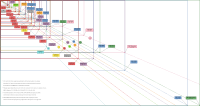
Photo from wikipedia
Purpose To present new clinical features, multimodal and ultrawide-field imaging characteristics of peripheral cone dystrophy (PCD), and results of laboratory and genetic investigation to decipher the etiology. Methods Retrospective observational… Click to show full abstract
Purpose To present new clinical features, multimodal and ultrawide-field imaging characteristics of peripheral cone dystrophy (PCD), and results of laboratory and genetic investigation to decipher the etiology. Methods Retrospective observational case-series. Results Three patients with PCD presented with bilateral paracentral scotomas and a mean visual acuity of 20/25. All exhibited confluent macular hyperautofluorescence with a central bull's eye lesion. Spectral-domain optical coherence tomography revealed loss of outer retinal elements, particularly the inner segment ellipsoid band and external limiting membrane, within the area of macular hyperautofluorescence. This area corresponded with a lightened fundus appearance and variable retinal pigment epithelium (RPE) abnormalities. Full field and multifocal electroretinography distinguished PCD from other photoreceptor dystrophies. Ultrawide-field imaging revealed irregular peripheral retinal lesions in a distribution greater nasally than temporally and not contiguous with the macular lesion. Functional and anatomic testing remained stable over a mean follow-up of 3 years. Laboratory investigation for causes of uveitis was negative. Whole exome sequencing identified rare variants in genes associated with macular or cone dystrophy or degeneration. Conclusions In contrast to the original description, the funduscopic and fluorescein angiographic appearance of PCD is abnormal, although the defects are subtle. Peripheral lesions may be observed in some patients. Bilateral, symmetric, macular hyperautofluorescence associated with outer retinal atrophy that spares the fovea is a characteristic of PCD. Pathogenic variants in the same gene were not shared across the cohort, suggesting genetic heterogeneity. Further evaluation is warranted.
Journal Title: Journal of Ophthalmology
Year Published: 2018
Link to full text (if available)
Share on Social Media: Sign Up to like & get
recommendations!